
Posts Tagged: pitahaya
Learn to Dragon Fruit
2018 Pitahaya/Dragon Fruit Production Seminar
San Diego County Farm Bureau
420 South Broadway, Suite 200 | Escondido, CA 92025
Friday - August 24, 2018
7:00am – 4:30pm
TOPICS TO BE COVERED:
- San Diego County Agriculture – Water, Policies and Regulatory Update
- Pitahaya Research Update – Variety Evaluation and Performance, Genetic Characterization
- Irrigation Water Management Strategies and Pitahaya Irrigation
- Pitahaya Post Harvest Management & Sensory Evaluation
- Pitahaya or Dragon Fruit Markets and Marketing - An Overview and Global Perspective
- Pitahaya Orchard Establishment & Economics Considerations
- Pitahaya Fertility Management & Soil Analytical Reports (Tentative)
- Nematode Issues and their Impact for Pitahaya Production
- Insect Pest Management & Pesticide Use Safety for Pitahayas and Other Specialty Crops
- Weeds and Weed Management Strategies for Specialty Crops, including Pitahaya
- Diseases – Diagnosis and Management Strategies for Pitahaya Production
- Hydroponics – An Evaluation of Soilless Substrates for Pitahaya Production (Tentative)
2018 Pitahaya/Dragon Fruit Festival/Field Day
UC South Coast Research and Extension Center
7601 Irvine Boulevard | Irvine, CA 92618
Saturday - August 25, 2016
6:30am – 3:30pm
TOPICS TO BE COVERED:
- Review of Pitahaya Varieties and Hand Pollination Demonstration
- Integrated Pest Management Strategies for Specialty Crops Production
- Pitahaya Irrigation Research and System Design Consideration
- Pitahaya Trellis Systems Demonstration
- Pitahaya Production for Home or Backyard Growers
- Pitahaya or Dragon Fruit and Ice Cream Tasting
REGISTRATION INFORMATION
-PLEASE READ-
REGISTER EARLY. This event has sold out in the past!! Attendance is limited to 60 participants for the seminar on August 24th and 100 for the festival/field day on August 25th. This would also help us plan for handouts and cuttings. No refunds will be issued, but substitutions are allowed.
PRICINGincludes continental breakfast, refreshments, lunch, (Catered by Phil's BBQ on 8/24), pitahaya/dragon fruit ice cream, smoothie tasting, and an information packet:
- Package Registration for Seminar & Festival/Field Day: $80.00,
If paid online with a credit card or post-marked by Friday - August 17, 2018.
No package registrations after this date.
- Seminar Registration ONLY: $60.00,
If paid online with a credit card or post-marked by Friday - August 17, 2018
$70.00 after this date or at the door, if space allows*
- Festival/Field Day Registration ONLY: $ 40.00,
If paid online with a credit card or post-marked by Friday - August 17, 2018
$50.00 after this date or at the door, if space allows*
*Walk-ins will be allowed if space is available, but you MUST have exact change or checks. Credit cards will NOT be accepted day of.
Please be aware that you WILL be turned away if space is not available! NO EXCEPTIONS.
TO REGISTER,please complete the online registration form at:
https://ucanr.edu/survey/survey.cfm?surveynumber=25236
For registration questions, please contact
Erin Spaniel
Administrative Assistant II
858-822-7919

pitahaya flower
What Caused that Symptom???
Diseases, disorders and other plant problems are critical concerns for the wholesale nursery. These include biotic problems — caused by living organisms such as pathogens, nematodes, and insects and other arthropods — as well as abiotic problems — caused by factors such as temperature and moisture extremes, mechanical damage, chemicals,
nutrient deficiencies or excesses, salt damage and other environmental factors. Many plant problems, especially biotic problems, if not recognized and controlled early in their development, can result in significant economic damage for the producer. Therefore, timely and accurate diagnoses are required so that appropriate pest and disease
management options and other corrective measures can be implemented.
Definition of Plant Diagnosis and Steps
Diagnosis is the science and art of identifying the agent or cause of the problem under investigation. When one renders a diagnosis, one has collected all available information, clues and observations and then arrives at an informed conclusion as to the causal factor(s). Hence, plant problem diagnosis is an investigative, problem-solving process that involves the following steps:
- Ask and answer the appropriate questions to define the problem and
obtain information that is relevant to the case under investigation.
- Conduct a detailed, thorough examination of the plants and production areas.
- Use appropriate field diagnostic kits and lab tests to obtain clinical information on possible causal agents and factors.
- Compile all the collected information and consult additional resources and references.
- Finally, make an informed diagnosis.
Throughout this process compile all notes, observations, maps, laboratory results, photographs and other information. This compilation will be the information base for the present diagnosis and can also be a useful resource for future diagnostic cases. Keep an open mind as the information is analyzed and do not make unwarranted assumptions.
Distinguishing Abiotic and Biotic Problems
The first step is to determine whether the problem is caused by an infectious agent, and this can be difficult. Plant symptoms caused by biotic factors such as infectious diseases and arthropod pests are oftensimilar to damage caused by other factors. Leaf spots, chlorosis, blights, deformities, defoliation, wilting, stunting and plant death can
be common symptoms of both biotic and abiotic problems; therefore, the presence of these symptoms does not necessarily mean the problem is a disease. Some general guidelines for distinguishing abiotic and biotic
problems follow and are summarized in table 1.
Table 1 DISTINGUISHING ABIOTIC AND BIOTIC PROBLEMS |
||
Characteristics |
Abiotic |
Biotic |
Hosts |
often affects several species or plants of various ages |
often affects one species or cultivar of the same age |
Pattern of plant symptoms |
often related to environmental or physical factors or cultural practices; may be regular or uniform |
often initially observed in random or irregular locations |
Rate of symptom development |
relatively uniform, extent of damage appears similar among plants |
relatively uneven, time of appearance and damage severity varies among affected plants |
Signs |
no evidence of the kinds of pests or pathogens known to cause the current symptoms |
presence of insects, mites, |
Spread |
is not infectious, is not progressive, commonly caused by one incident and does not spread |
infectious, spreads on host over time if environmental conditions are suitable |
Recurrence |
possibly previously associated with current or prior environmental conditions or cultural practices |
possibly caused by pests that |
Adapted from Table 18, ANR Pub 3420 |
||
Biotic problems. Identifying biotic problems is sometimes facilitated if signs of a pathogen, primarily the growth of a fungus, are present. The most obvious examples of such signs are the mycelium and spores produced by rusts and powdery and downy mildews. However, in other cases nonpathogenic fungican grow on top of damaged plant tissues and appear to be signs of a pathogen, resulting in possible misdiagnoses.
Biotic problems often affect one species or cultivar of the same age and typically are initially observed in random or irregular locations; symptoms appear at varying times, and severity varies among affected plants. Biotic problems are infectious, spreading when environmental conditions are favorable, and may be associated with pests that have affected the crop. This infectious aspect is important, as biotic diseases will many times be progressive and continue to affect
additional tissues and more plants.
Abiotic problems. In contrast to biotic factors, abiotic problems often affect several species or plants of various ages; typically, damage is relatively uniform, doesn't spread and is often not progressive. Abiotic problems are not associated with pests. They are often caused by a single incident and are related to environmental or physical factors or cultural practices. Once the responsible factor has dissipated and is no longer affecting the plant, the plant may grow out of the problem and develop new, normal appearing foliage.
Diagnosing Biotic Problems
Infectious diseases. To confirm if a problem is caused by a pathogenic fungus, bacterium, nematode, or virus, it is often necessary to have symptomatic tissues analyzed by a trained horticulturalist or plant pathologist. Such experts will attempt to microscopically observe the agent and recover it, if culturable, through isolation procedures. Lab analysis is particularly important to determine if multiple pathogens are infecting the plant. A downside is that obtaining a diagnosis from lab analysis is not a fast process. However, quick test kits (fig. 1A) are available that can be used to rapidly identify many common diseases in the field.
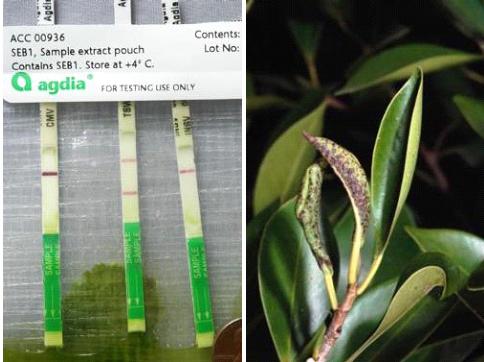
A B
Fig.1. Diagnosing biotic
problems. Plant pathogens can sometimes be rapidly diagnosed using
commercially available quick tests, such as these test strips for
viruses (A). Arthropod pests such as Cuban laurel thrips (shown here on Ficus) cause feeding damage, which can help in pest identification (B). Photos: S.T. Koike (A), J. K. Clark (B).
It is worthwhile to emphasize that diagnosing plant diseases requirescareful examination of the entire plant specimen. Symptoms on leaves, stems, or other above ground plant parts might lead one to suspect that afoliar pathogen is involved. However, these symptoms could also resultif the roots are diseased. Therefore, it is important to conduct a
complete examination of the symptomatic plant.
Because biotic diseases are caused by living microorganisms, the collecting and handling of samples is particularly critical. Samples that are stored for too long a time after collecting or that are allowedto dry out or become hot (if left inside a vehicle, for example) will sometimes cause the pathogen in the sample to die, making pathogen recovery and identification impossible. Plants that have been diseased for a long time and that are in the late stages of disease development will often be colonized by nonpathogenic saprophytic organisms. If these tissues are collected, it will be difficult to recover the primarypathogen of concern because of the presence of these secondary decay organisms. Root samples should be collected carefully as diseased rootsare sometimes difficult to dig out of the potting mix or soil, are
usually colonized by the pathogen as well as secondary agents, and are very sensitive to high temperatures and drying conditions.
Arthropod and other invertebrate pests. Insects,mites, slugs and snails cause damage while feeding on the plant (fig. 1B). Feeding damage is usually associated by the type of feeding characteristics and mouthparts of the insect or pest. For example, mites and insects such as whiteflies, aphids and mealybugs have tubular sucking mouthparts that suck plant fluids, causing buds, leaves, or flowers to discolor, distort, wilt, or drop. Thrips have rasping mouthparts that result in dried out, bleached plant tissue. Caterpillars, weevils, snails and slugs have chewing mouthparts that
make holes and cuts in foliage or flowers. They can also prune plant parts and sometimes consume entire plants.
If present, these pests are visible with the naked eye, a 10 X hand lens, or stereomicroscope, all depending upon their size. An assessment of whether the identified arthropod or invertebrate matches the plant damage it is associated with must be determined. Sometimes the identified arthropod or invertebrate may not be the sole problem or
could, in fact, be a beneficial organism or insignificant pest.
Aphids, whiteflies, thrips, leafhoppers and some other insects that suck plant juices may vector pathogens such as viruses and phytoplasmas (and to a lesser extent fungi and bacteria). They can feed on infected plants, acquire the pathogen, feed on healthy host plants and transmit the pathogen to the new host. The insects do not necessarily have to bepresent in large numbers to cause a significant disease outbreak. The insect vectors are not always present at the same time the disease symptoms are being expressed.
The excrement and byproducts from these pests can also provide clues that the pests have been or are actively present. Caterpillars and other chewing pests produce dark excrement or droppings. Greenhouse thrips and plant bugs produce dark, watery, or varnish-like droppings onfoliage. Aphids, whiteflies, soft scales, and some other sap-sucking insects excrete excess plant fluids as honeydew, a sticky sap, which provides a medium for the growth of sooty mold.
Diagnosing Abiotic Problems
Nutrient deficiencies and toxicities. Nutrientdeficiencies and toxicities reduce shoot growth and leaf size, cause leaf chlorosis (fig.2A), necrosis and dieback of plant parts. However, nutrient deficiencies cannot be reliably diagnosed on the basis of symptoms alone because numerous other plant problems can produce similarsymptoms. There are general symptoms that can be expressed by deficiencies of nutrients but usually leaf and/or soil samples are
needed to confirm the problem.
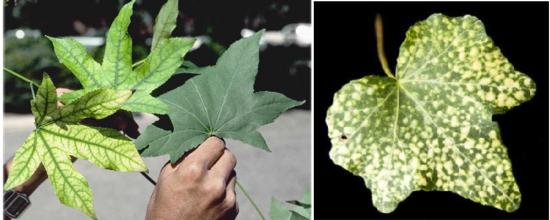
A B
Fig. 2. Examples of abiotic problems. Iron deficiency on sweet gum (Liquidambar styracifolia) showing interveinal chlorosis (A). Chorotic spots on Hedera caused by a miticide application at a higher dosage rate than specified on the pesticide label (B). Photos: E. Martin (A), S. A. Tjosvold (B).
Herbicide, insecticide and fungicide phytotoxicity. Herbicidesused to control weeds in crops or in non-cropped areas sometimes injureornamental crops when they are not used in accordance with label instructions. Examples include when an herbicide is used in or around sensitive non-target crops, when an herbicide rate is increased above tolerable limits, or when an applicator makes a careless application. By understanding the mode of action of the herbicide, one can determine if the symptom fits an herbicide application. Herbicide detection in affected plants is possible with the help of a specialized laboratory but the analysis can be expensive. To minimize the cost of testing, the laboratory will need to know the suspected herbicide or its chemical group to narrow the analysis. Pesticides and fungicides occasionally cause obvious plant damage.
Symptoms can vary widely. Generally, flower petals are more susceptible to damage from pesticide applications than are leaves. The younger and more tender the leaves the more susceptible they are to pesticide applications. Hot weather can exacerbate the damage the chemicals cause. Pesticides that have systemic action can have a more profound effect. Some active ingredients can adversely affect the photosynthetic mechanism or other physiological processes and can resulti n a general leaf chlorosis, interveinal chlorosis, leaf curling and stunting. Emulsifiable concentrate (EC) formulations, soaps and oils can adversely affect the waxy surface layer that protects the leaf from desiccation. Applications with these products can result in the loss ofthe shiny appearance of a leaf, leaf spotting and necrosis. Pesticidesapplied as soil drenches can cause poor germination, seedling death, or
distorted plant growth.
Check label precautions against use on certain species. Make sure thepesticide is not applied more frequently or at a higher rate (fig. 2B) than recommended, or that the pesticide is not mixed with incompatible pesticides. When in doubt as to whether the plant species is sensitive to the pesticide, spray a few plants and observe them for several days to a week for any signs of damage before spraying any more of the plants.
Physiological and Genetic Disorders
There are numerous disorders that can occur because of environmental extremes — too much or too little of an environmental element such as light, temperature, water, or wind. Sunburn is damage to foliage and other herbaceous plant parts caused by a combination of too much light and heat and insufficient moisture. A yellow or brown area develops on foliage, which then dies beginning in areas between the veins. Sunscaldis damage to bark caused by excessive light or heat. Damaged bark becomes cracked and sunken. Frost damage causes shoots, buds and
flowers to curl, turn brown or black and die. Hailstones injure leaves,twigs, and in serious cases even the bark. Chilling damage in sensitive plants can cause wilting of foliage and flowers and development of dark water-soaked spots on leaves that can eventually turn light brown or bleached, and die. Physical and mechanical injury can occur when plants are mishandled during transport or routine cultural practices. Wounds might serve as entry sites for plant pathogens and can attract boring insects to woody stems.
In closed environments such as greenhouses and nursery storage areas,plants can be exposed to toxic levels of ethylene gas. Sources of ethylene include improperly functioning or unvented greenhouse heaters; exhaust from engines of forklifts and vehicles; cigarette smoke; damaged, decaying, or dying plants; and ripe or decaying fruit. Toxic levels of ethylene gas can cause premature abscission of flower buds, petals (fig. 3) and leaves. Other symptoms include wilted flowers, chlorosis, twisted growth or downward bending of stems and leaves and undersized or narrow leaves.
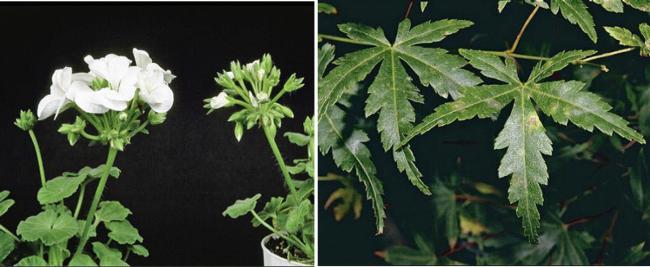
A B
Fig. 3. Poor air quality can
lead to physiological disorders. Shattering (petal drop) on geranium was
caused by plant exposure to low levels of ethylene in the greenhouse or
during postharvest storage (A). Yellowish and brownish patches on
Japanese maple leaves are damage caused by ozone (B), an outdoor air
pollutant. Photos: J. K. Clark.
Outdoors, exposure of nursery plants to air pollutant gases such as ozone (fig. 3), carbon monoxide, nitrous oxides and sulfur dioxide can cause damage. Typical symptoms vary widely, but include slow growth anddiscolored, dying, or prematurely dropping foliage. Damage is often found where plants are located near sources of polluted air such as near
freeways or industries or where weather and topography concentrate the pollutants.
Sometimes plants or plant shoots exhibit an unusual and sudden changeof color producing discrete markings of variegation. For example, a plant with entirely green leaves suddenly produces a shoot that has leaves with edges lacking green pigment, stripes, or blotches. A new shoot such as this is probably a chimera (fig. 4). It is produced when a genetic mutation occurs in a specific region of the growing tip resulting in a section with genetically different cells. The ostensible result of the genetic change is dependent on the arrangement of the genetically different cells in the shoot tip and their expression. This can lead to sometimes bizarre variegation forms or sometimes forms thatare quite desirable. Sometimes variegation can be caused by viruses. Viruses usually cause non-uniform chlorosis, such as mosaics, while
chimeras usually produce patterned forms such as variegation of color onleaf margins, stripes, or complete loss of pigment. Some viroids may also cause bleaching of pigments in leaves; such symptoms, however, are generally produced throughout the plant and are not restricted to a single shoot. Some nutrient disorders can cause variegation but these disorders usually do not arise from a specific shoot as with chimeras.
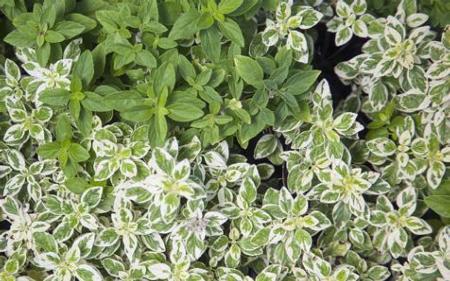
Fig. 4. Genetic disorder.
Growing points with variegated leaves can sometimes arise spontaneously
from some species such as this Origanum. Genetic variants such as this are sometimes confused with plants with virus disease or nutrient deficiency symptoms. Photo: S. A. Tjosvold.
Steve Tjosvold is Environmental Horticulture Advisor and
Steve Koike is Plant Pathology Farm Advisor, UC Cooperative Extension,
Santa Cruz and Monterey counties.
This article was condensed from: Diagnosing Plant
Problems, Chapter 11. In Newman, J. (ed) Container Nursery Production
and Business Management. Univ. of Calif. Agric. and Nat. Resources.
Publication 3540. Richmond, CA.
References
Boxer P, Sandmann G. 1989. Target sites of herbicide action. Boca Raton, FL: CRC Press.
Costello L, Perry E, Matheny N, Henry M, Geisel P. 2003. Abiotic
disorders of landscape plants: A diagnostic guide. Oakland: University
of California Division of Agriculture and Natural Resources Publication
3420.
Derr JF, Appleton BL. 1988. Herbicide injury to trees and shrubs: A
pictorial guide to symptom diagnosis. Virginia Beach, VA: Blue Crab
Press.
Dreistadt SH. 2001. Integrated pest management for floriculture and
nurseries. Oakland: University of California Division of Agriculture and
Natural Resources Publication 3402.
Eagle, DJ. 1981. Diagnosis of herbicide damage to crops. New York, NY: Chemical Publishing Co.
Grogan RG. 1981. The science and art of plant disease diagnosis. Annual Review of Phytopathology 19:333–351.
Ratzinger EJ, Mallory-Smith C. 1997. Classification of herbicides by
the site of action for weed resistance management strategies. Weed
Technology 11:384–393.
Schubert TS, Breman LL. 1988. Basic concepts of plant disease and how
to collect a sample for disease diagnosis. Plant Pathology Circular No.
307. Florida Department of Agriculture and Consumer Services, Plant
Pathology Circular No. 307.
Sharma MP. 1986. Recognizing herbicide action and injury. Alberta Environmental Centre, Alberta Agriculture. Agdex 641–647.
Shurtleff MC, Averre CW. 1997. The plant disease clinic and field
diagnosis of abiotic diseases. St. Paul, MN: American Phytopathological
Society Press.
Stewart TM, Galea VJ. 2006. Approaches to training practitioners in
the art and science of plant disease diagnosis. Plant Disease
90:539–547.
Tickes B, Cudney D, and Elmore C. 1996. Herbicide injury symptoms.
Tucson, AZ: University of Arizona Cooperative Extension Publication No.
195021.
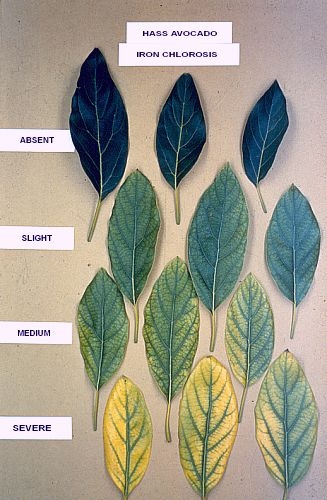
avocado chlorosis
Ventura Dragon Fruit Workshop
2017 Pitahaya/Dragon Fruit Production Tour – Ventura
UC Hansen Agricultural Research and Extension Center
14292 W Telegraph Rd. | Santa Paula, CA 93060
Enter on Briggs Road Entrance
Phone: (805) 525-9293 |Fax: (805) 525-5475
Monday – October 2, 2017
Self Driven Tour-Volunteer Drivers Needed for Carpooling
Tour Itinerary & Agenda:
7:00 am Registration, Continental Breakfast, Welcome and Introductions - Ramiro Lobo, UCCE San Diego, Ben Faber and Jose Fernandez de Soto, Ben Faber UCCE San Diego
7:45 am Depart for MVP Ranch in Fillmore, CA. – Tour hosted by Jose Fernandez, UCCE Hansen REC and Ramiro Lobo, UCCE San Diego County
9:15 am Depart for Thille Ranch in Santa Paula, CA. – Tour hosted by Dave Pommer
11:00 am Depart for UC Hansen REC in Santa Paula, CA. – Tour hosted by Jose Fernandez de Soto, UC Hansen REC
12:30 pm LUNCH, Pitahaya Fruit and Ice Cream Tasting, Pitahaya Cutting Exchange
2:00 pm Adjourn
Topics to be Discussed/Highlighted:
- Overview of farming operations visited
- Variety selection, planting, trellis and growing systems (pots vs. soils, shade vs. full sun, etc.)
- Pitahaya or Dragon Fruit Irrigation and water quality Issues
- Pitahaya orchard establishment & economics considerations
- Pitahaya/Dragon Fruit Varieties, Pollen Collection and Pollination Demonstration
- Integrated Pest Management (IPM) for pitahayas and other specialty crops
- Pitahaya fertility management & fertilizer practices
- Nematode issues for pitahaya production
- Pitahaya/Dragon Fruit Tasting and cutting exchange – Please bring/donate fruit for the tasting and get feedback from other growers (10 pieces of fruit needed)
Register Online at: http://ucanr.edu/2017-pitahayaventura
Registration Questions: Contact Roland Hills - 858.822.7711 or Erin Spaniel - 858.822.7919
Program Information: Contact Ramiro Lobo - 858.243.4608 or Jose Fernandez - 760.996.4874

pitahaya

pitahaya flower
S. California Can Grow Just About Anything including avocado and citrus
It seems the world is attacked on all sides, including the iconic citrus and avocado industries in California. Aside from the other agricultural issues all growers have of water, labor, costs, weather, family, you name it, citrus and avocado growers have particular problems. There is Asian Citrus Psyllid/Huanglongbing for citrus and the Shot Hole Borers for Avocado. The latter is a beast that is going to lay waste to many other tree species besides avocado, like sycamore, coast live oak, native maple and many other tree species.
Citrus and avocado are still strong industries in California and will remain so as solutions to these pest invasions are dealt with. But we are coming up to the time when maybe other tree crops should be considered. These alternative tree crops come with new promise, but they also come with problems. You have to figure out how to market them. The California industry knows what to do with an avocado and a grower knows where to go with a ‘Gold Nugget' mandarin, but what do you do with a longan or cherimoya. You figure out how to market it, through direct marketing at farmers markets or the internet, some specialty marketer like Frieda's Finest or Melissa's or your regular packer who has taken an interest in your product.
I've spoken with growers who say they have grown such and such for four generations and they are not adjusted physically or psychologically to grow anything else. Well, it is good to stick with what you know best and refine it for current conditions, but it's also good to keep options open. Stick to what is best for your situation and support the studies needed to make citrus and avocado strong industries, but also think about maybe something else.
Here's links to tree crops that do well in Southern California and for that matter can be adjusted to much of California. Just watch out, it gets cold north of the Grapevine and San Luis Obispo and options are more limited with subtropicals, but think deciduous.
Subtropicals
http://ceventura.ucanr.edu/Com_Ag/Subtropical/Fruit_and_Nut_Varieties/Citrus_and_Other_Subtropicals/
Deciduous
http://ceventura.ucanr.edu/Com_Ag/Subtropical/Fruit_and_Nut_Varieties/Deciduous/
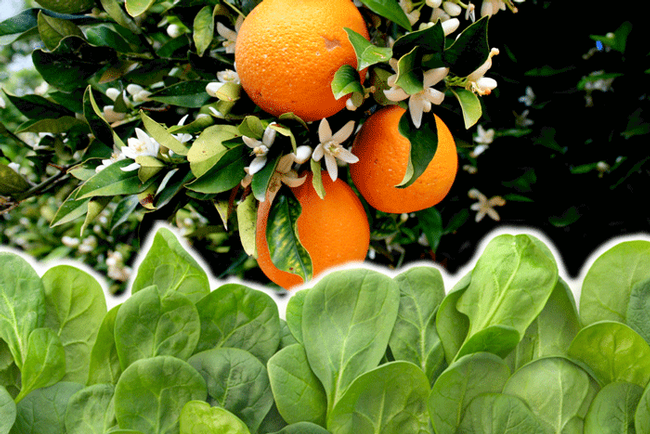
citrus-spinach
Learn About New Produce Marketing Channels in Los Angeles
Meet the Buyer: An L.A. Produce Market Tour for Los Angeles Growers and Food Advocates
Do you want to find new channels for selling your produce and make connections with produce buyers? Join us on a one day tour of produce distributors in the L.A. area where you will meet with senior buyers and leaders at these distribution companies committed to building their local base of suppliers:
Santa Monica Farmers' Market - our early start will allow for a special behind-the-scenes market tour to learn about the vibrant business-to-business transactions occuring there every week.
Space Exploration Technologies - meet the culinary team feeding the folks at the frontier of space exploration seasonally-inspired menus, much of it sourced from farms nearby.
Whole Food Distribution Center - talk with buyers committed to small, local and organic producers at the new state-of-the-art distribution facility and enjoy a yummy lunch.
Heath & Lejeune - learn the art of distributing orgranic produce from a seasoned buyer / seller.
These high-level buyers are positioned to appreciate your farm and products—whether organic, local, family-owned, sustainably grown, or high quality specialty crops. You'll gain an understanding of what it takes to work with them, have a chance to network with other farmers, and learn tips on how to tell a compelling story about your farm and its products that will expand your sales opportunities. This tour will be valuable for ANY farmer who wants to learn more about different distribution channels for their products, as well as for healthy food advocates and policy makers who want to have a better understanding of what small farms need to do in order to connect with willing buyers.
Space is limited; advance registration is required. Please reserve your space by December 4th, 2015. Lunch and snacks will be provided. There is no charge for this tour thanks to our generous sponsors.

Sign up at:
https://www.eventbrite.com/e/meet-the-buyer-an-la-produce-market-tour-for-los-angeles-growers-and-food-advocates-tickets-19216471985

farmers market
